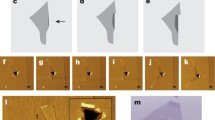Abstract
In spite of years of intense research, graphene continues to produce surprising results. Recently, it was experimentally observed that under certain conditions graphene can self-drive its tearing and peeling from substrates. This process can generate long, micrometer sized, folded nanoribbons without the action of any external forces. Also, during this cracking-like propagation process, the width of the graphene folded ribbon continuously decreases and the process only stops when the width reaches about few hundreds nanometers in size. It is believed that interplay between the strain energy of folded regions, breaking of carbon-carbon covalent bonds, and adhesion of graphene-graphene and graphene-substrate are the most fundamental features of this process, although the detailed mechanisms at atomic scale remain unclear. In order to gain further insights on these processes we carried out fully atomistic reactive molecular dynamics simulations using the AIREBO potential as available in the LAMMPS computational package. Although the reported tearing/peeling experimental observations were only to micrometer sized structures, our results showed that they could also occur at nanometer scale. Our preliminary results suggest that the graphene tearing/peeling process originates from thermal energy fluctuations that results in broken bonds, followed by strain release that creates a local elastic wave that can either reinforce the process, similar to a whip cracking propagation, or undermine it by producing carbon dangling bonds that evolve to the formation of bonds between the two layers of graphene. As the process continues in time and the folded graphene decreases in width, the carbon-carbon bonds at the ribbon edge and interlayer bonds get less stressed, thermal fluctuations become unable to break them and the process stops.
Similar content being viewed by others
References
K. S. Novoselov, D. Jiang, F. Schedin, T. J. Booth, V. V. Khotkevich, S. V. Morozov, A. K. Geim, Proc. Natl. Acad. Sci. U.S.A. 102, 10451 (2005).
C. Lee, X. Wei, J. W. Kysar and J. Hone, Science 321, 385 (2008).
A. H. Castro Neto, F. Guinea, N. M. R. Peres, K. S. Novoselov and A. K. Geim, Rev. Mod. Phys. 81, 109 (2009).
S. Park and R. S. Ruoff, Nat. Nanotechnol. 4, 217 (2009).
R. Balog, B. Jørgensen, L. Nilsson, M. Andersen, E. Rienks, M. Bianchi, M. Fanetti, E. Lægsgaard, A. Baraldi, S. Lizzit, Z. Sljivancanin, F. Besenbacher, B. Hammer, T. G. Pedersen, P. Hofmann, and L. Hornekær, Nat. Mater. 9, 315 (2010).
R.H. Baughman, H. Eckhardt, M. Kertesz, J. Chem. Phys. 87, 6687 (1987).
R. S. Edwards and K. S. Coleman, Nanoscale 5, 38 (2013).
D. Akinwande, C. J. Brennan, J. S. Bunch, P. Egberts, J. R. Felts, H. Gao, R. Huang, J. –S. Kim, T. Li, Y. Li, K. M. Liechti, N. Lu, H. S. Park, E. J. Reed, P. Wang, B. I. Yakobson, T. Zhang, Y. –W. Zhang, Y. Zhou and Y. Zhu, Extreme Mechanics Letters 13, 42 (2017).
X. Li, L. Tao, Z. Chen, H. Fang, X. Li, X. Wang, J. –B. Xu and H. Zhu, Appl. Phys. Rev. 4, 021306 (2017).
A. F. Fonseca, T. Liang, D. Zhang, K. Choudhary, S. R. Phillpot and S. B. Sinnott, ACS Appl. Mater. Interfaces 9, 33288 (2017).
B. Amorim, A. Cortijo F. de Juan, A. G. Grushin, F. Guinea, A. Gutiérrez-Rubio, H. Ochoa, V. Parente, R. Roldán, P. San-Jose, J. Schiefele, M. Sturla and M. A. H. Vozmediano, Phys. Rep. 617, 1 (2016).
A. R. Muniz and A. F. Fonseca, J. Phys. Chem. C 119, 17458 (2015).
D. G. Papageorgiou, I. A. Kinloch and Robert J. Young, Progress in Materials Science 90, 75 (2017).
T. Zhang, X. Li and H. Gao, Int. J. Fract. 196, 1 (2015).
J. Annett and G. L. W. Cross, Nature 535, 271 (2016).
E. Hamm, P. Reis, M. Leblanc, B. Roman and E. Cerda, Nature Materials 7, 386 (2008).
D. W. Brenner, O. A. Shenderova, J. A. Harrison, S. J. Stuart, B. Ni and S. B. Sinnott, J. Phys.: Condens. Matter 14, 783 (2002).
LAMMPS - Molecular Dynamics Simulator. Available at http://lammps.sandia.gov (accessed 9 December 2017).
A. Goriely and T. McMillen, Phys. Rev. Lett. 88, 244301 (2002).
Author information
Authors and Affiliations
Rights and permissions
About this article
Cite this article
Fonseca, A.F., Galvão, D.S. Self-Driven Graphene Tearing and Peeling: A Fully Atomistic Molecular Dynamics Investigation. MRS Advances 3, 463–468 (2018). https://doi.org/10.1557/adv.2018.120
Published:
Issue Date:
DOI: https://doi.org/10.1557/adv.2018.120




